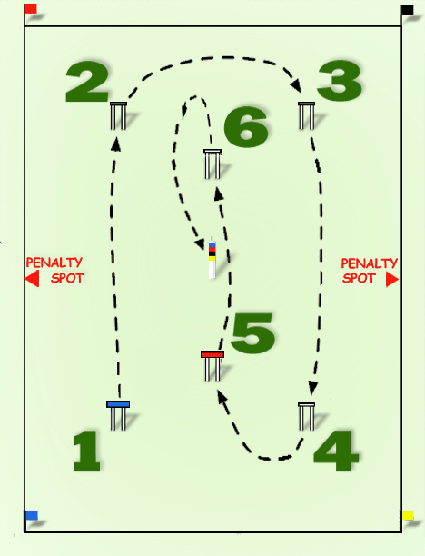
|
Back to |
| The Front Page |
| The Game |
|
Aussie Croquet-- who, where, when, why, and how it is played |
|
by Bob Alman with considerable thanks to Jim Nicholls, John Curington, Nancy Avera, and George Enochs Posted July 12, 2017
|
The price of Egypt's coming into the World Croquet Federation in the late 80's was a promise to produce annual world championships in their national game: Golf Croquet. As Golf Croquet soared in popularity around the world, Association Croquet purists grumbled about "lessor games" polluting the sport. But by the time top-level players in the West began beating the Egyptians in this decade, the deal was sealed: Golf Croquet--while disparaged as "pat and chat"--is here to stay. In many countries and clubs around the world, Golf Croquet--understandable and playable in just a few minutes--constitutes the introduction to croquet given to novices. What they play after they join the club depends on where they are. Many continue to play Golf Croquet. Others advance to Association Croquet or to American Rules. In North Florida, however, and in the mountains of Western North Carolina, yet another game is taking hold....

|
| Perhaps the greatest unintentional gift Jim Nicholls brought to the Ponte Vedra Croquet Club in his seasonal tenure there in 2017 was the introduction of what we are calling "Aussie Croquet." |
Jim Nicholls, well-known coach and event director in Wagga-Wagga, Australia, was one of many who tried Ricochet and considered how it could best be used for training players. He thought of a few adjustments that might make it work better at the club level but didn't try them out at the time.
Bringing the game to America
Now flash-forward to the 2016 World Championship at the National Croquet Center in West Palm Beach, in April. Bob Alman had been asked to vet players in the top 100 rankings for a potential "pro" position at a new and large club in Jacksonville, and Jim Nicholls was the most promising prospect he found.
Eventually Nicholls agreed to come to the Ponte Vedra Croquet Club for four months of the peak season in 2017--January through April--and something entirely unexpected happened. He decided to try out his innovations with the members. When he introduced "Aussie Croquet" they immediately embraced it. John Curington, the owner and financer of the unique seven-court club, has become an outspoken advocate of Aussie Croquet: "By the time Jim left in May to go back to Australia, we had decided to teach all our new members Aussie Croquet on their second visit to the club."
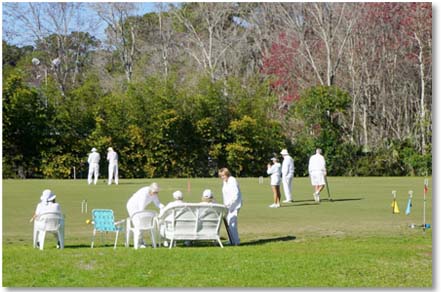
|
| This is where Aussie Croquet was first played in America: the north lawn of the Ponte Vedra Croquet Club. Fred Hunt photo. |
Curington has gone so far as to suggest that the game ought to be considered for sanctioning by the United States Croquet Association. Most Golf Croquet players don't renew their individual memberships for the USCA. If Aussie Croquet succeeds as a transition to the advanced games, both the clubs and players would have a stronger bond with the national organization for the sport.
Small changes make a big difference
The innovations Jim Nicholls tried out at Ponte Vedra were few and simple. The most consequential one guaranteed predictable, invariable rotation of play giving every player in the game the certainty of a turn coming up soon--because a player may hit other balls for bonus strokes only once in a turn. With no need to sit down, players are thus encouraged to stay in the game, both physically and mentally, to consider strategy for the next rotation.

|
| John Curington ignited the spark that has spread to North Carolina, simply by hiring Jim Nicholls as a high-season coach and program director at his Ponte Vedra Croquet Club near Jacksonville, Florida. |
Nicholls elaborates: "Golf Croquet players don't like waiting around while one person makes a break--a big turn off. So limiting the break is a big plus. And at some point they themselves will have a break--perhaps starting them on the path towards Association Croquet." Nicholls found that the game in its design is an effective "leveller," allowing and encouraging players at many different levels of skill to compete in the same game, either as partners or opponents. "We have already seen that here in Wagga," Jim wrote, having observed the same effects at his home club after he returned to Australia.
Planting the seed, from Florida to North Carolina
Nancy Avera and her husband Les were early converts to the game at the Ponte Vedra Croquet Club. She established a popular "Wicket Women" group for Wednesday mornings to learn and play Aussie Croquet with Jim's oversight, beginning in March.
In the summers, Nancy and her husband Les live at Lake Toxaway in North Carolina, so in mid-May, Nancy became the essential link in a chain of interest that brought the game to the North Carolina mountains. She soon persuaded George Enochs, a self-described "croquet missionary" who contributed to the establishment of interclub events among the ten resorts in close proximity, that Aussie Croquet could be in ideal "next game" for the 1400 or so members of those country clubs who play mostly Golf Croquet.
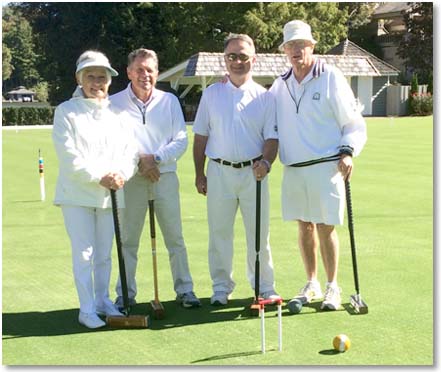
|
| In the fall of 2016, Jane and George Enochs finally persuaded Lake Toxaway's golf pro and assistant to try Golf Croquet. Everyone seemed satisfied with the result. George predicts that after a few more seasons of play, they could be better at croquet than at golf. |
Nancy told me, "I took the game to George and Jane in Toxaway. They liked it and wanted to teach Aussie on Thursday mornings. They've been instructing the game since late May. Their enthusiasm is contagious. They tell me 12 to 15 people come to play on Thursdays, and that others play game on their own."
Many Golf Croquet players become weary of the game eventually and want to do something "more interesting." Enochs thinks Aussie Croquet is the ideal solution for those players. They can learn and practice more of the shooting skills critical for success in the advanced games.
The Lake Toxaway Mallet Club's annual championship in 2017 will feature, for the first time there or anywhere in America, Aussie Croquet as well as Golf Croquet.
According to Nancy, "Four Ponte Vedra Croquet Club members took the game to Highlands, where it was immediately declared a better game than Golf Croquet." Highlands is the western-most of the North Carolina country clubs along that stretch of Highway 64 and Toxaway is the eastern-most. With only 30 miles in between, it's a natural incubator for friendly interclub rivalry.
Re-languaging the rules for normal people
| DEVISING A COMMON LANGUAGE |
|
Most people don't play the associated "sport" of croquet, so they don't understand its special and arcane lingo--reason enough to normalize the language of these rules. And as always in this magazine, we strive for "North Atlantic English" to bridge weirdnesses in American and Commonwealth English. If we have succeeded, these rules can be understood by...
|
We set ourselves the goal of agreeing on not just the language but the rules themselves. We never achieved alignment on one major point, with respect to scoring rover. Some insisted that the best/most interesting strategy for rover play allows only ONE bonus shot for hitting peg, not two. Others objected, "Enough strategy is required in getting around the circuit of six hoops without adding more time and struggle to peg out both balls...."
Both points of view are valid. So in addition to the "local option" allowed for having a boundary margin of either nine inches or three feet (when the "destination" is either American Rules or Association Croquet) we include at the end of our universal rules an "advanced play" option.
How far local club players should "advance" will likely remain a hot debate for as long as there is a sport called croquet. While Association Croquet purists disparage games played with croquet equipment that fall short of the glorious complexity of AC, most of them never achieve facility with triple peels, long regarded as the essential mark of excellence. Many high-level "training games" are designed to require peels in order to win. Training games at the other end of the spectrum, however, are disparaged as much as Golf Croquet. One player remarked, "If you don't peel, you might as well play American Rules."
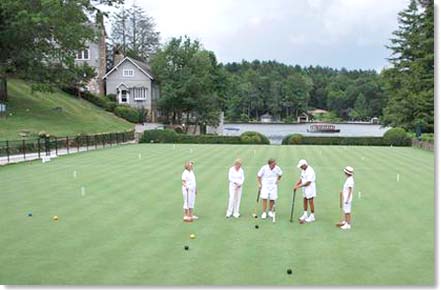
|
The Lake Toxaway croquet lawns instantly attracted national attention when they opened nearly a decade ago, hosting celebrity players in a series of golf croquet invitations and the USCA sanctioned Golf Croquet National Championship. On these courts in the fall, the Lake Toxaway Mallet Club's annual club championship will feature, for the first time, Aussie Croquet as well as Golf Croquet. Below, the Burlingame club is among ten-or-so country clubs in the North Carolina Mountains with a combined membership of 1400 croquet players, all of them potential players of Aussie Croquet in interclub events. |
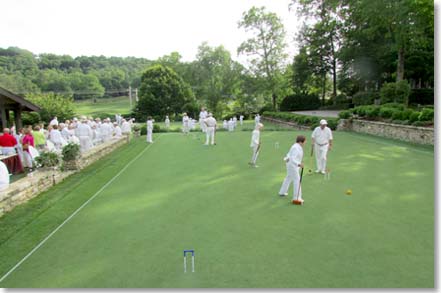
|
Finally, it can be said--and Jim Nicholls says it clearly: "Both Ricochet and Aussie Croquet are, in my opinion, excellent practice routines or fun games but should not be promoted as competitive versions of croquet. There are already too many versions!" John Riches makes the same comment in his explication of the game on the Oxford Croquet site.
But in America, at least, that question remains to be settled.
|
UNIVERSAL RULES FOR AUSSIE CROQUET
This two-sided game is played on a 6-hoop court of any size. All the shots are exactly the same as those in Golf Croquet, but this game calls for more advanced mallet and ball skills, partner collaboration, and forward planning. The game may be played with satisfaction by players at all levels of proficiency.
Object of the Game
Overview of the Rules The game starts with each ball in turn being hit from halfway through the first hoop--the one with the blue top. Each turn is only one shot, unless bonus shots are earned. Bonus shots are earned when the striker ball...
The striker ball may hit any of the other three (object) balls only once during a turn. There is no "croquet shot" in this game; that is, when a hit is made, the striker ball does not lift to contact to the hit ball; striker plays its two bonus shots from the position it achieved after the hit. Bonus shots do not accumulate. Only the last earned can be used. After the striker ball hits a dead ball, the turn ends, all balls affected after the fault was made are replaced to their former positions, and the striker ball is placed on the penalty spot of the opponents' choosing. If the striker ball goes out of bounds at any time during its turn, the turn ends and the striker ball is immediately marked in on the boundary margin (uniformly either nine inches or three feet, by the event director's choice.) The striker ball may hit other balls out of bounds and still earn two bonus shots. Any balls hit out of bounds are placed on the boundary margin after completion of the turn (either nine inches or three feet, at the director's discretion).
Rover Balls
Bonus Shots
Dead Balls
Faults
Playing out of Turn
The Course
Directors' Options Boundary Margins: A nine-inch margin, as in American Rules, is the most challenging. The three-foot boundary margin is consistent with Association Croquet. Court Dimensions: The game can be played satisfactorily on reduced-size courts.
|
